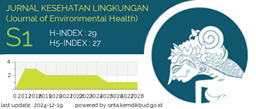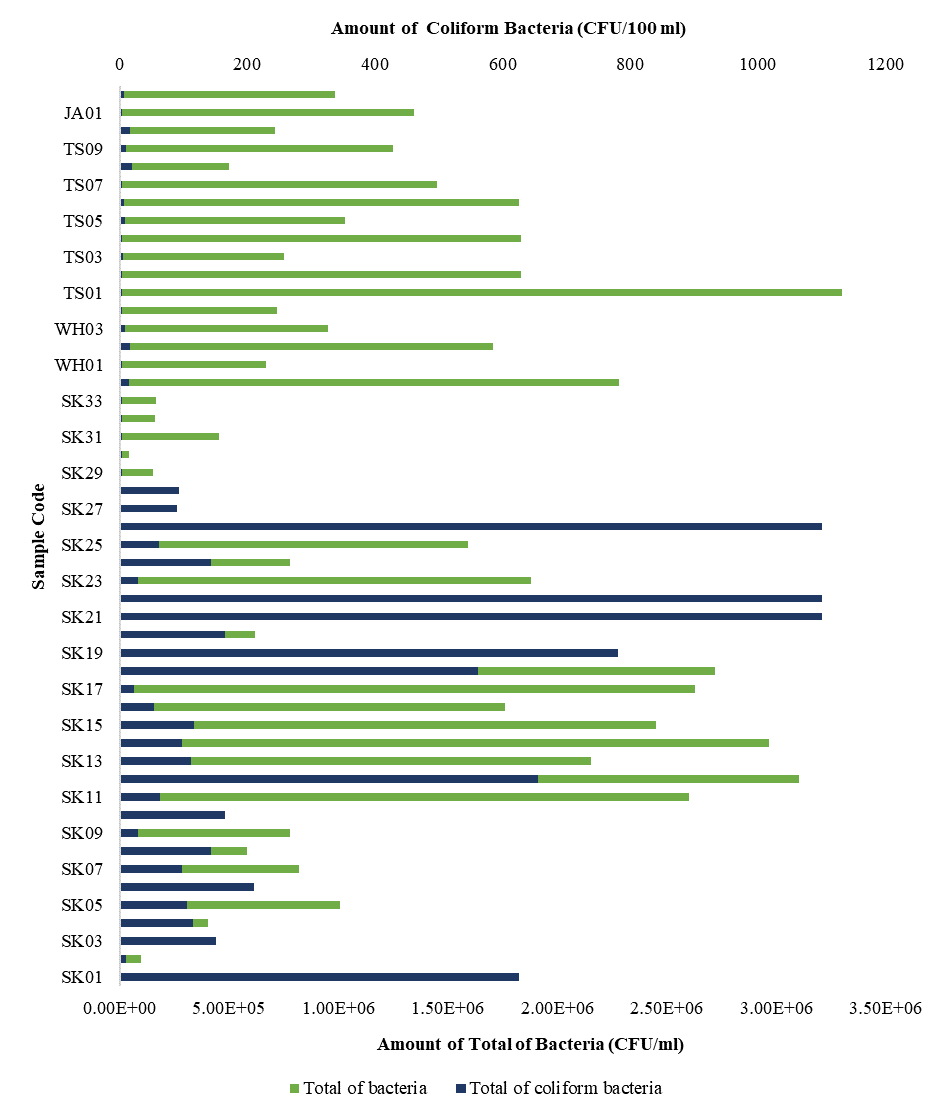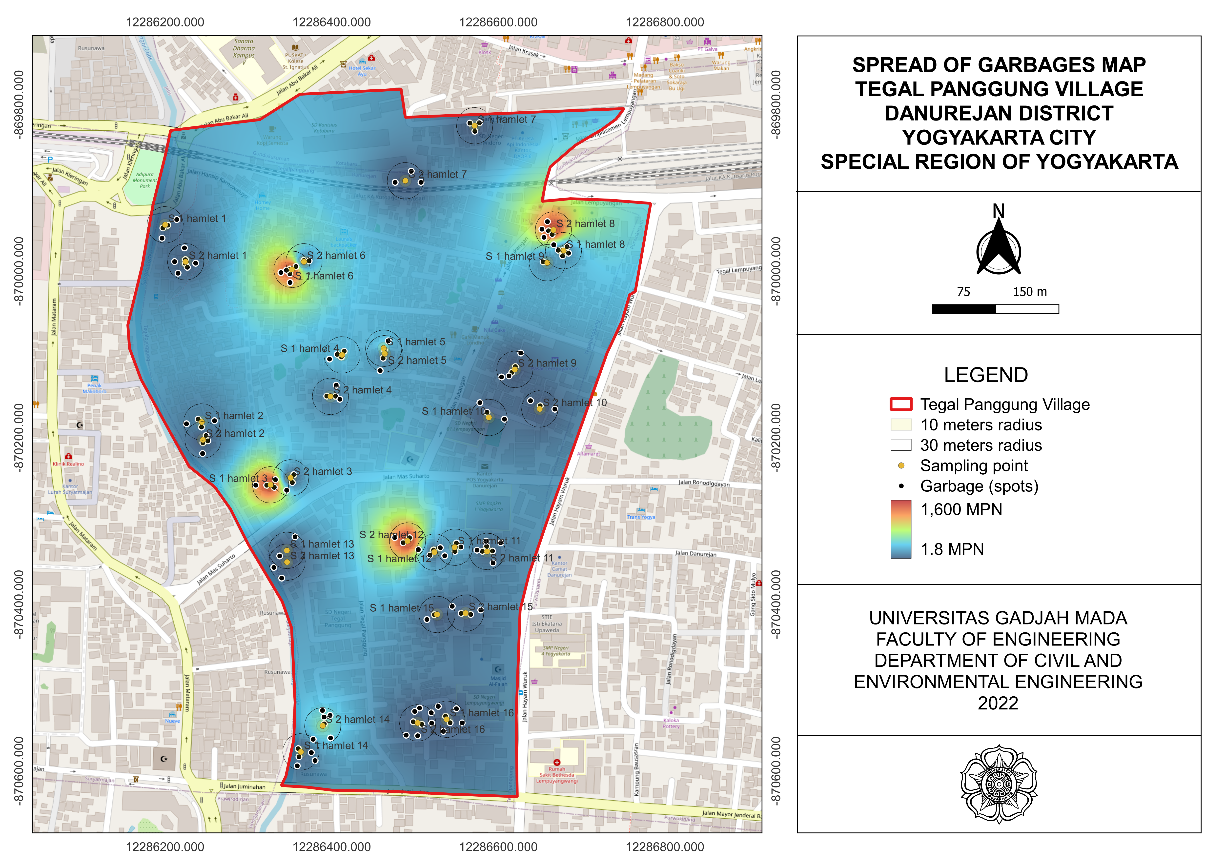Exploring the Association Between Air Pollutant Exposure and Krebs von den Lungen-6 (KL 6) Serum Levels in Outdoor and Indoor Workers in Banyumas District, Central Java

Introduction: Indonesia ranks 8th globally in the air pollution index, with poor air quality causing premature deaths from lung ailments such as interstitial lung diseases. Krebs von den Lungen-6 (KL 6) can be used to detect lung disease caused by air pollution. However, the number of studies investigating the link between air pollutant exposure and KL-6 levels is inadequate. The present study explores the association between air pollutant exposure and KL-6 levels in workers in different settings. Methods: This cross-sectional study recruited 70 individuals who were divided into two groups. Dust levels were measured using a particle counter as a proxy for air pollutant levels. KL-6 levels were measured with ELISA. The Spearman correlation test, Mann-Whitney test, and generalized linear model were used in statistical analyses. Results and Discussion: Air pollutant exposure differed significantly between outdoor and indoor settings (p = 0.000). A significant difference was found in KL-6 serum levels between outdoor and indoor workers (p = 0.000). Air pollutant levels were inversely associated with KL-6 serum levels in outdoor (r = -0.557, p < 0.05) and indoor workers (r = -0.360, p < 0.05). Working duration did not significantly correlate with KL-6 serum levels in either group. A tendency of linear association among air pollutant exposure, overall working duration, and KL-6 serum levels was found in the multivariable model. Conclusion: Work settings were associated with varying exposures to air pollutants and KL-6 serum levels. Higher exposure to pollutants may be associated with an increase in KL-6 serum levels.
Ruhiat F, Heryadi D, Akim. Strategi NGO Lingkungan dalam Menangani Polusi Udara di Jakarta (Greenpeace Indonesia). Andalas J Int Stud. 2019;8(1):16–30. https://doi.org/10.25077/ajis.8.1.16-30.2019
Babatola SS. Global Burden of Diseases Attributable to Air Pollution. J Public Health Africa. 2018;9(813):162-166. https://doi.org/10.4081/jphia.2018.813
Somboonsin P, Canudas-Romo V. Mortality Attributable to Fine Particulate Matter in Asia, 2000–2015: A Cross-Sectional Cause-Of-Death Analysis. BMJ Open. 2021;11(5):e043605. http://dx.doi.org/10.1136/bmjopen-2020-043605
Greenstone M, Fan Q. Indonesia's Worsening Air Quality and Its Impact on Life Expectancy. Chicago: Air Quality Life Index; 2019. https://aqli.epic.uchicago.edu/wp-content/uploads/2019/03/Indonesia-Report.pdf
Mannucci PM, Franchini M. Health Effects of Ambient Air Pollution in Developing Countries. Int J Environ Res Public Heal. 2017;14(9):1048. https://doi.org/10.3390/ijerph14091048
Ji W, Park YR, Kim HRH-C, Kim HRH-C, Choi C-M. Prolonged Effect of Air Pollution On Pneumonia: A Nationwide Cohort Study. European Respiratory Society. 2017;50(Suppl 61):OA467. https://doi.org/10.1183/1393003.congress-2017.OA467
Kim HJ, Choi MG, Park MK, Seo YR. Predictive and Prognostic Biomarkers of Respiratory Diseases due to Particulate Matter Exposure. J Cancer Prev. 2017;22(1):6-15. https://doi.org/10.15430/JCP.2017.22.1.6
Yani H, Dewi S, Rahmadi AR. Correlation between Serum Krebs von den Lungen-6 Levels with Forced Vital Capacity and Modified Rodnan Skin Score of Patients with Restrictive Lung Disease in Diffuse-Type Systemic Sclerosis. Indones J Rheumatol. 2019;11(2):145-147. https://doi.org/10.37275/ijr.v11i2.133
Bonella F, di Marco F, Spagnolo P. Pulmonary Function Tests in Idiopathic Pulmonary Fibrosis. United States: In Humana Press; 2019. https://doi.org/10.1007/978-3-319-99975-3_5
Lanzarone N, Gentili F, Alonzi V, Bergantini L, D'Alessandro M, Rottoli P, et al. Bronchoalveolar Lavage and Serum KL-6 Concentrations in Chronic Hypersensitivity Pneumonitis: Correlations with Radiological and Immunological Features. Intern Emerg Med. 2020;15(7):1247–1254. https://doi.org/10.1007/s11739-020-02281-8
Qin H, Xu XP, Zou J, Zhao XJ, Wu HW, Zha QF, et al. Krebs von den Lungen-6 Associated With Chest High-Resolution CT Score in Evaluation Severity of Patients with Interstitial Lung Disease. Pulmonology. 2019;25(3):143–148. https://doi.org/10.1016/j.pulmoe.2018.05.008
Suhaimi NF, Jalaludin J. Biomarker as a Research Tool In Linking Exposure To Air Particles And Respiratory Health. Biomed Res Int. 2015;2015(1):962853. https://doi.org/10.1155/2015/962853
Stainer A, Faverio P, Busnelli S, Catalano M, Della Zoppa M, Marruchella A, et al. Molecular Biomarkers in Idiopathic Pulmonary Fibrosis: State of the Art and Future Directions. Int J Mol Sci. 2021;22(6255):1-25. https://doi.org/10.3390/ijms22126255
Zhang T, Shen P, Duan C, Gao L. KL-6 as an Immunological Biomarker Predicts the Severity, Progression, Acute Exacerbation, and Poor Outcomes of Interstitial Lung Disease: A Systematic Review and Meta-Analysis. Front Immunol. 2021;12(745233):1-11. https://doi.org/10.3389/fimmu.2021.745233
Xue C, Wu N, Li X, Qiu M, Du X, Ye Q. Serum Concentrations of Krebs von den Lungen-6, Surfactant Protein D, and Matrix Metalloproteinase-2 as Diagnostic Biomarkers In Patients with Asbestosis and Silicosis: A Case-Control Study. BMC Pulm Med. 2017;17(144):1-9. https://doi.org/10.1186/s12890-017-0489-0
Dewi J. KL-6/MUC-1 sebagai Penanda Penyakit Paru Interstisial. Cermin Dunia Kedokt. 2018;45(1):67–70. http://dx.doi.org/10.55175/cdk.v45i1.158
Zheng P, Liu X, Huang H, Guo Z, Wu G, Hu H, et al. Diagnostic Value of KL-6 in idiopathic Interstitial Pneumonia. J Thorac Dis. 2018;10(8):4724–4732. http://dx.doi.org/10.21037/jtd.2018.07.54
d'Alessandro M, Bergantini L, Cameli P, Lanzarone N, Antonietta Mazzei M, Alonzi V, et al. Serum KL-6 Levels in Pulmonary Langerhans' Cell Histiocytosis. Eur J Clin Invest. 2020;50(8):e13242. https://doi.org/10.1111/eci.13242
Bergamaschi E, Bellisario V, Macrí¬ M, Buglisi M, Garzaro G, Squillacioti G, et al. A Biomonitoring Pilot Study in Workers from a Paints Production Plant Exposed to Pigment-Grade Titanium Dioxide (TiO2). Toxics. 2022;10(171):1-18. https://doi.org/10.3390/toxics10040171
Liu Q, Zhang H, Han B, Jiang H, Chung KF, Li F. Interstitial Lung Abnormalities: What Do We Know and How Do We Manage? 2021;15(12):1551–1561. https://doi.org/101080/1747634820211997598
Nakadate T, Yamano Y, Yamauchi T, Okubo S, Nagashima D. Assessing the chronic Respiratory Health Risk Associated with Inhalation Exposure to Powdered Toner for Printing in Actual Working Conditions: A Cohort Study On Occupationally Exposed Workers Over 10 Years. BMJ Open. 2018;8(10):e022049. http://dx.doi.org/10.1136/bmjopen-2018-022049
Firmansyah ZZ, Astuti TW, Duta GA. Increased Serum KL-6/MUC1 Level, Neutrophils and Lymphocytes Sputum in Malang Splendid Bird Market Workers. J Respirologi Indones. 2020;40(2):75–81. https://doi.org/10.36497/jri.v40i2.103
Aisyah A, Ikhtiar M, Fachrin S. Pengaruh Kualitas Udara Ambien dan Karakteristik Individu terhadap Kapasitas Paru Tukang Parkir Kota Makassar. Wind Heal J Kesehat. 2018;1(3):154–165. https://garuda.kemdikbud.go.id/documents/detail/757556
Azizah ITN. Analysis the Level of PM2,5 and Lung Function of Organic Fertilizer Industry Workers in Nganjuk. J Kesehat Lingkung. 2019;11(2):141-149. http://dx.doi.org/10.20473/jkl.v11i2.2019.141-149
Adelia N, Mulyasari TM. Kadar Debu Udara pada Bagian Produksi UD.Mandiri di Desa Teluk Kecamatan Purwokerto Selatan Kabupaten Banyumas tahun 2018. Bul Keslingmas. 2019;38(2):190–198. https://doi.org/10.31983/keslingmas.v38i2.4877
Negida A. Sample Size Calculation Guide - Part 7: How to Calculate the Sample Size Based on a Correlation. Adv J Emerg Med. 2020;4(2):e34. https://www.ncbi.nlm.nih.gov/pmc/articles/PMC7163254/
Hidayat R, Wulandari P. Enzyme Linked Immunosorbent Assay (ELISA) Technique Guideline. Biosci Med J Biomed Transl Res. 2021;5(5):447–453. https://doi.org/10.32539/bsm.v5i5.228
Tomy L, Chesneau C, Madhav AK. Statistical Techniques for Environmental Sciences: A Review. Math Comput Appl. 2021;26(74):1-31. https://doi.org/10.3390/mca26040074
Schober P, Vetter TR. Nonparametric Statistical Methods in Medical Research. Anesth Analg. 2020;131(6):1862–1863. http://dx.doi.org/10.1213/ANE.0000000000005101
de Oliveira-Júnior JF, Gois G, da Silva EB, Teodoro PE, Johann JA, Junior CAS. Non-Parametric Tests and Multivariate Analysis Applied to Reported Dengue Cases in Brazil. Environ Monit Assess. 2019;191(7):1–19. https://doi.org/10.1007/s10661-019-7583-0
Sesé L, Nunes H, Cottin V, Sanyal S, Didier M, Carton Z, et al. Role of Atmospheric Pollution on the Natural History of Idiopathic Pulmonary Fibrosis. Thorax. 2018;73(2):145–150. http://dx.doi.org/10.1136/thoraxjnl-2017-209967
Loxham M, Nieuwenhuijsen MJ. Health Effects of Particulate Matter Air Pollution in Underground Railway Systems – A Critical Review of The Evidence. Part Fibre Toxicol. 2019;16(1):1–24. https://doi.org/10.1186/s12989-019-0296-2
Martinez FJ, Collard HR, Pardo A, Raghu G, Richeldi L, Selman M, et al. Idiopathic Pulmonary Fibrosis. Nature Reviews Disease Primers. 2017;3(17074):1–19. https://doi.org/10.1038/nrdp.2017.74
Leikauf GD, Kim SH, Jang AS. Mechanisms of Ultrafine Particle-Induced Respiratory Health Effects. Experimental and Molecular Medicine. 2020;52(1):329–337. https://doi.org/10.1038/s12276-020-0394-0
Hasan H, Maranatha RA. Perubahan Fungsi Paru Pada Usia Tua. J Respirasi. 2017;3(2):52–57. http://dx.doi.org/10.20473/jr.v3-I.2.2017.52-57
Ono T, Iwasaki T, Terada Y, Abe K, Lee J, Mochizuki M, et al. Serum KL-6 Elevation in a Uveitis Patient with Behçet's Disease Treated with Adalimumab. Am J Ophthalmol Case Reports. 2020;18(100660):1-3. https://doi.org/10.1016/j.ajoc.2020.100660
Ma H, Lu J, Song Y, Wang H, Yin S. The Value of Serum Krebs von den lungen-6 as a Diagnostic Marker in Connective Tissue Disease Associated with Interstitial Lung Disease. BMC Pulm Med. 2020;20(6):1–8. https://doi.org/10.1186/s12890-019-1043-z
Ye Y, Fu Q, Wang R, Guo Q, Bao C. Serum KL-6 Level is a Prognostic Marker in Patients with Anti-MDA5 Antibody-positive Dermatomyositis Associated with Interstitial Lung Disease. J Clin Lab Anal. 2019;33(8):e22978. https://doi.org/10.1002/jcla.22978
Glencross DA, Ho T-R, Camiña N, Hawrylowicz CM, Pfeffer PE. Air Pollution and Its Effects on The Immune System. Free Radic Biol Med. 2020;151(1):56–68. https://doi.org/10.1016/j.freeradbiomed.2020.01.179
Hu Y, Wang LS, Jin YP, Du SS, Du YK, He X, et al. Serum Krebs von den Lungen-6 Level As A Diagnostic Biomarker for Interstitial Lung Disease in Chinese Patients. Clin Respir J. 2017;11(3):337–345. https://doi.org/10.1111/crj.12341
Ko UW, Cho EJ, Oh HB, Koo HJ, Do KH, Song JW. Serum Krebs von den Lungen-6 Level Predicts Disease Progression in Interstitial Lung Disease. PLoS One. 2020;15(12):e0244114. https://doi.org/10.1371/journal.pone.0244114
Majewski S, Piotrowski WJ. Air pollution”An Overlooked Risk Factor for Idiopathic Pulmonary Fibrosis. Journal of Clinical Medicine. 2021;10(77):1–15. https://doi.org/10.3390/jcm10010077
Copyright (c) 2022 JURNAL KESEHATAN LINGKUNGAN

This work is licensed under a Creative Commons Attribution-NonCommercial-ShareAlike 4.0 International License.
1. Copyright of all journal manuscripts is held by the Jurnal Kesehatan Lingkungan.2. Formal legal provisions to access digital articles of electronic journal are subject to the provision of the Creative Commons Attribution-ShareAlike license (CC BY-NC-SA), which means that Jurnal Kesehatan Lingkungan is rightful to keep, transfer media/format, manage in the form of databases, maintain, and publish articles.
3. Published manuscripts both printed and electronic are open access for educational, research, and library purposes. Additionally, the editorial board is not responsible for any violations of copyright law.
JKESLING by UNAIR is licensed under a Creative Commons Attribution-ShareAlike 4.0 International License.







































